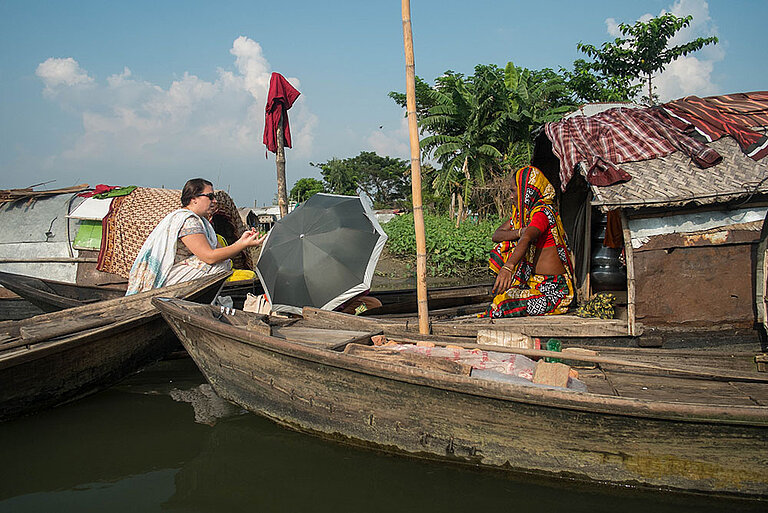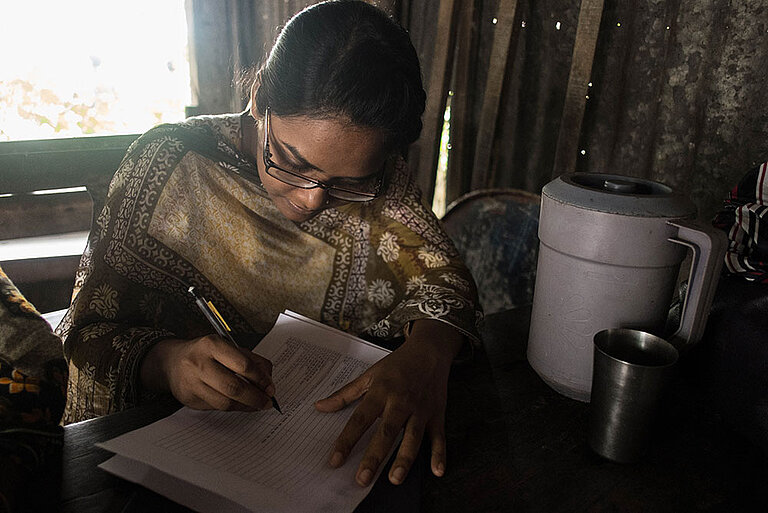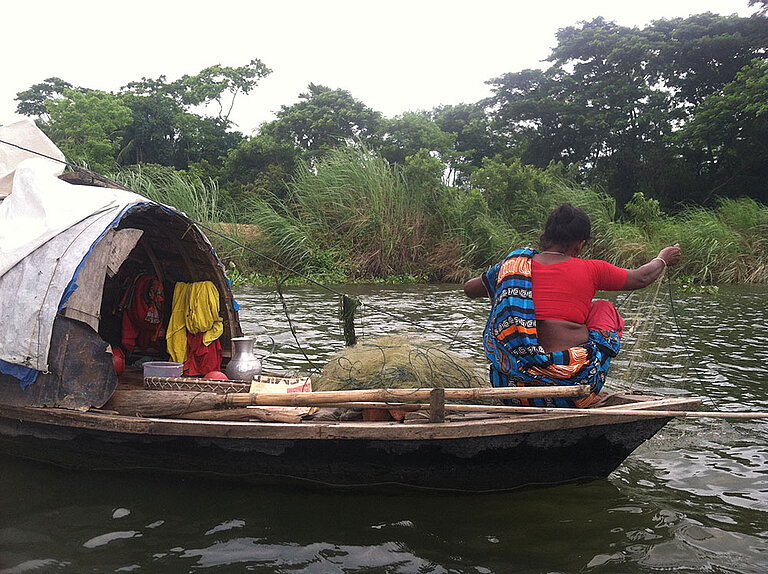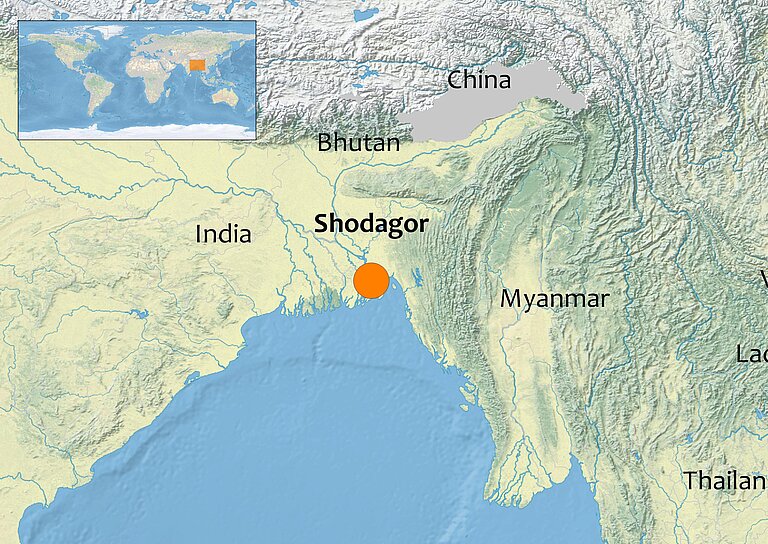Shodagor Fisher-Traders, Bangladesh



Site Details
The Shodagor are a group of traditionally boat-dwelling, semi-nomadic fishers and traders living near the banks of rivers and canals throughout rural Bangladesh.They are culturally distinct from the settled majority group in the country. The fieldsite for this project is in Matlab, a mostly rural subdistrict which is home to approximately 500 Shodagor families and 240,000 settled, majority Muslim, minority Hindu agriculturalists and wage laborers. Branches of the Meghna River, one of the three largest and most voluminous rivers in the country’s extensive river system, make up the southern and northern boarders of Matlab, with the confluence of the Meghna and Padma (the main distributary of the Ganges River) Rivers falling just to the south of the subdistrict. Matlab is also bisected by the Dhonagoda River, which is where most Shodagor families live and work. Families reside either on small, wooden houseboats, clustered within groups along the rivers and in the canals, or have movedonto land within the last 5-10 years and live primarily in make-shift houses built on stilts. There are two primary seasons in Bangladesh that are relevant for Shodagor families: the dry season (usually October through March), and the rainy season (usually April through September).
Shodagor communities are primarily organized around nuclear family dwellings, with boats or houses rarely large enough for extended families, although it is common to live within the same boat community with extended family members. Shodagor fisher-traders engage in a mixed subsistence and cash economy. In 2014, 90% of men sampled and 39% of women caught fish as their primary occupation, and 40% of women worked as traders. Most of the fish are sold for cash in nearby markets, and traders also earn cash, though 80% of fishing households reported regularly eating some of their catch. Shodagor women who work as housewives (21% in 2014) do not earn income or forage for other resources, and the remaining 10% of men worked in fixed-income jobs, either in local markets or as daily wage laborers. Resources and childcare tend to be concentrated within the nuclear family, with resources pooled at the household level and little sharing of food or cash between households, although extended family members do often help with childcare.
Research
My work with Shodagor communities has two main areas of focus: 1) the behavioral ecology of household divisions of labor, specifically the tradeoffs women make between productive labor and childcare, as well as fathers’ roles in the household; 2) health and reproductive outcomes of economic and parenting decision-making. In more than 18 months of fieldwork to date, I have used a mixed-methods approach to study these topics. This includes focus groups, structured and semi-structured interviews, spot samples and focal follows, anthropometric measurements, GPS data collection, and collection of biological markers of health, including measures of C-reactive protein using dried blood spots and risk for anemia (Hb) and diabetes (HbA1C) using point-of-care testing. Funding from and collaborations with MPI support collection of longitudinal demographic and anthropometric data from all Shodagor families in Matlab.
Selected Publications
Starkweather, K. E., Keith, M. H., Zohora, F., & Alam, N. (2022). Economic impacts and nutri-tional outcomes of the 2017 floods in Bangladeshi Shodagor fishing families. American Journal of Human Biology. doi.org/10.1002/ajhb.23826
Starkweather, K. E., & Reynolds, A. Z. (2022). Shodagor women’s work and cooperative childcare networks. Philosophical Transactions of the Royal Society.
Starkweather, K. E., Keith, M. H., Prall, S. P., Alam, N., & Emery Thompson, M. (2021). Paternal care and growth rates in Shodagor children. Developmental Psychobiology.
Hames, R. B., & Starkweather, K. E. (2021). Polyandry. In G. Ritzer, & C. Rojek (Eds.), The Blackwell Encyclopedia of Sociology. John Wiley & Sons, Ltd.
Starkweather, K. E., Shenk, M. K., & McElreath, R. (2020). Biological constraints and socioe-cological influences on women’s pursuit of risk and the sexual division of labor. Evolutionary Human Sciences, 2, 1-24.
Reynolds, A. Z., Wander, K., Sum, C. Y., Su, M., Emery Thompson, M., Hooper, P. L., Li, H., Shenk, M. K., Starkweather, K. E., Blumenfield, T., & Mattison, S. M. (2020) Matriliny reverses gender disparities in inflammation and hypertension among the Mosuo of China. Proceedings of the National Academy of Sciences.
Broesch, T., Crittenden, A. N., Beheim B. A., Blackwell, A. D., Bunce, J. A., Colleran, H., Hagel, K., Kline, M., McElreath, R., Nelson, R. G., Pisor, A. C., Prall, S., Pretelli, I., Purzycki, B., Quinn, E. A., Ross, C., Scelza, B. A. Starkweather, K. E, Stieglitz, J., & Borgerhoff Mulder, M. (2020). Navigating cross-cultural research: methodological and ethical considerations. Proceedings of the Royal Society, B.
Scelza, B. A., Prall, S. P., & Starkweather, K. E. (2020). Paternity confidence and social obli-gations explain men’s allocations to romantic partners in an experimental giving game. Evolution and Human Behavior. doi:10.1016/j.evolhumbehav.2019.10.007.
Starkweather, Kathrine E. and Keith, Monica H. (2019). One piece of the matrilineal puzzle: The socioecology of maternal uncle investment. Philosophical Transactions of the Royal Society, 374. https://doi.org/10.1098/rstb.2018.0071
Starkweather, Kathrine E. and Keith, Monica H. (2018). Estimating Impacts of the Nuclear Family and Heritability of Nutritional Outcomes in a Boat-Dwelling Community. American Journal of Human Biology, 30, e23105.
Starkweather, Kathrine E. (2017). Shodagor Family Strategies: Balancing work and family on the water. Human Nature, 28, 138-166.
Links
Website of Kathrine Starkweather: kathrinestarkweather.com
